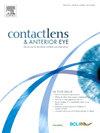软性隐形眼镜不良事件与角膜矢状深度的关系。
IF 3.7
3区 医学
Q1 OPHTHALMOLOGY
引用次数: 0
摘要
目的:确定出现软接触镜不良事件(角膜浸润事件或微生物性角膜炎)的个体角膜矢状深度是否比人群平均水平浅。方法:招募在过去两年内发生不良事件的参与者(N = 25)进行前瞻性病例对照研究。采用单样本t检验,从地形图(中心角膜测光、偏心率、直径12 mm)计算角膜矢状面深度,并与历史对照(已发表,总体均值±SD = 2.74±0.15 mm, N = 18,387只眼)进行比较。Bland-Altman分析比较了地形计算的矢状面深度与前段光学相干断层扫描(AS-OCT)图像(12毫米弦)的测量结果,以验证其有效性。通过图像/视频测量隐形眼镜的运动和贴合。结果:参与者(平均±SD年龄= 27.4±10.4岁,年龄范围18至65岁)主要为女性(25人中有19人)。地形计算的矢状深度略大于AS-OCT测量值,但与AS-OCT测量值高度相关(差异的平均值±SD = 0.14±0.08 mm, t = 8.97, p)。结论:不良事件的隐形眼镜佩戴者的角膜矢状深度明显浅于人群平均值。这些数据表明,对于角膜矢状深度较浅的患者来说,一种尺寸适合大多数软性隐形眼镜的矢状深度可能太深,这可能会抑制眼睛的自然防御。未来的研究应该比较角膜矢状深度的相对风险与其他已知的风险因素,并根据矢状深度确定软性隐形眼镜配戴的临床指南。本文章由计算机程序翻译,如有差异,请以英文原文为准。
The relationship between soft contact lens adverse events and corneal sagittal depth
Purpose
To determine if individuals who develop soft-contact-lens adverse events (corneal infiltrative events or microbial keratitis) have a shallower corneal sagittal depth than the population mean.
Methods
Participants (N = 25) with an adverse event within the last two years were recruited for a prospective, case-control study. Corneal sagittal depth was calculated from topography (central keratometry, eccentricity, 12 mm diameter) for comparison with an historical control (published, population mean ± SD = 2.74 ± 0.15 mm, N = 18,387 eyes) using one-sample t-tests. Bland-Altman analyses compared topography-calculated sagittal depth to measurements from anterior segment optical coherence tomography (AS-OCT) images (12 mm chord), for validation. Contact lens movement and fit were measured from images/videos.
Results
Participants (mean ± SD age = 27.4 ± 10.4 years, range 18 to 65 years) were predominantly female (19 of 25). Topography-calculated sagittal depth was slightly larger than, but highly correlated with, AS-OCT measurements (mean of the differences ± SD = 0.14 ± 0.08 mm, t = 8.97, p < 0.0001; r = 0.82, p < 0.0001). The mean ± SD sagittal depth for participants (2.64 ± 0.14 mm) was significantly shallower than the population mean (t = − 3.52, p = 0.002). Primary gaze contact lens movement (mean ± SD) was 0.24 ± 0.17 mm, range: 0.06 to 0.82 mm and up gaze was 0.45 ± 0.33 mm, range: 0.05 to 1.16 mm.
Conclusions
Contact lens wearers with adverse events had a corneal sagittal depth that was significantly shallower than the population mean. These data suggest that one-size-fits-most soft contact lenses may have a sagittal depth that is too deep for patients with a shallower-than-typical corneal sagittal depth, which presumably inhibits the eye’s natural defenses. Future studies should compare the relative risk of corneal sagittal depth to other known risk factors and determine clinical guidelines for fitting soft contact lenses based on sagittal depth.
求助全文
通过发布文献求助,成功后即可免费获取论文全文。
去求助
来源期刊

Contact Lens & Anterior Eye
OPHTHALMOLOGY-
CiteScore
7.60
自引率
18.80%
发文量
198
审稿时长
55 days
期刊介绍:
Contact Lens & Anterior Eye is a research-based journal covering all aspects of contact lens theory and practice, including original articles on invention and innovations, as well as the regular features of: Case Reports; Literary Reviews; Editorials; Instrumentation and Techniques and Dates of Professional Meetings.
 求助内容:
求助内容: 应助结果提醒方式:
应助结果提醒方式:


